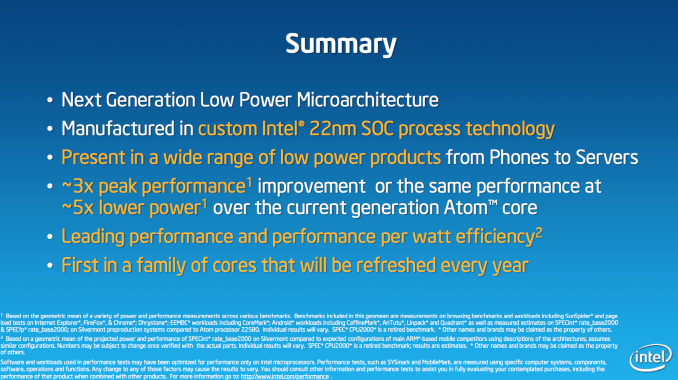Intel’s Silvermont Architecture Revealed: Getting Serious About Mobile
by Anand Lal Shimpi on May 6, 2013 1:00 PM EST- Posted in
- CPUs
- Intel
- Silvermont
- SoCs
Final Words
Silvermont really is Intel’s Conroe for the mobile market, but not in the sense that many have been expecting. Given that success in mobile is so closely tied to device wins, Silvermont alone isn’t enough. Unlike Conroe, a very competitive Silvermont won’t change the world overnight. What Silvermont does however is offer a great foundation for Intel going forward. Conroe lead to Penryn, Nehalem, Westmere, Sandy Bridge, Ivy Bridge and soon, Haswell. It was the platform that Intel could build on regularly by executing on tick-tock. Conroe paved the way for the insane advantage Intel has held onto for the past few years. Silvermont is like Conroe in that it provides that same foundation.
The mobile market is far more competitive than the PC industry was back when Conroe hit. There isn’t just one AMD but many competitors in the SoC space that are already very lean and fast moving. There’s also the fact that Intel doesn’t have tremendous marketshare in ultra mobile. Silvermont may feel a lot like Conroe, but the market it’s competing in is very different. That’s not to say that Intel can’t be successful here; it’s just not going to be easy.
Architecturally Silvermont is very conservative, and that’s not a bad thing. A side effect of not wanting to make Haswell irrelevant by a far lower cost part is the benefit of maintaining power efficiency. Intel joins the ranks of Apple and Qualcomm in intelligently scaling performance while respecting power consumption. Intel’s 22nm process should give Silvermont a lot of runway to use. If it can quickly follow up with 14nm, Silvermont’s power advantage could end up being akin to Conroe’s performance advantage in the mid-2000s.
Even so, Silvermont is long overdue. It’s the first mobile architecture where Intel really prioritized smartphones and tablets, and on paper, it looks very good. Now it’s up to Intel to turn a great architecture into great design wins. From what I’m hearing, we may actually see that happen.











174 Comments
View All Comments
t.s. - Tuesday, May 7, 2013 - link
If Intel play fair few years back, maybe now we have competitive offerings from AMD. That practice Intel's doing hurt AMD alot. Until now.Homeles - Monday, May 6, 2013 - link
I'm sure Anand would be drawing plenty of comparisons if he had a Temash tablet in hand.Bob Todd - Monday, May 6, 2013 - link
As an owner of two Bobcat systems (laptop/mini-itx), I don't think a 25% boost from Jaguar is going to get us into the realm of "good enough" cpu performance for general computing in Windows. The same goes for Intel unless Silvermont is significantly faster than Jaguar. I'm excited that Intel is finally bringing something interesting to the table, even if we end up two to three generations away from a good experience in Windows with their (and AMD's) mobile offerings. This sounds like it will make for a beastly dual core Android phone though, even at lower clocks.jjj - Monday, May 6, 2013 - link
Hilarious difference in attitude when it comes to Intel.Tegra 4 gets into phones by "aggressively limiting frequency." while Intel " Max clock speeds should be lower than what’s possible in a tablet, but not by all that much thanks to good power management. "
Objectivity at it's best.
Homeles - Monday, May 6, 2013 - link
Your scenario is a false equivalency.Krysto - Monday, May 6, 2013 - link
Is it? I wouldn't accuse Anand of "objectivity" when it comes to Intel, whether it's on purpose, or involuntary.nunomoreira10 - Monday, May 6, 2013 - link
The point is tegra 4 was not exactly made for phones while Intel was, for that you have tegra4iits not exacly nvidia fault, everybody complained that tegra 3 was lacking, now tegra 4 which is competitive consumes to much, atleast there is a choice.
Homeles - Monday, May 6, 2013 - link
A15s are big cores in relation to its relatives. The only way to fit not 2, not 4, but *5* of them in a phone on 28nm is to downclock them agressively. Just like the only way to fit Ivy Bridge in a tablet is to downclock it agressively.Anand did point out that the "the only A15 SoCs we've seen have been very leaky designs optimized for high frequency," and that if power consumption were prioritized instead (which I believe Tegra 4i is supposed to be), it would be less of a blowout.
It's silly getting defensive about stock ARM cores anyways. It's not an attack on Nvidia by saying their stock ARM cores aren't all too spectacular -- it's not like they poured blood, sweat and tears into making their A15s the best thing ever.
Finally, Tegra 4 is on a process that is rather significantly inferior to Intel's 22nm process. You think Nvidia would have to downclock agressively if they were on a level playing field and using Intel's 22nm process? I sure don't. But jjj and others here feel the need to get defensive whenever songs of praise are being sung about Intel, even when it's well deserved.
extide - Tuesday, May 7, 2013 - link
I am in agreeance with what you said, but I do believe Tegra 4i is Cortex A9, not A15 like Tegra 4.Wilco1 - Tuesday, May 7, 2013 - link
The Korean Galaxy S4 has a 1.8GHz Exynos Octa, Tegra 4 does 1.9GHz. In what way are these "aggressively downclocked"? They run at their maximum frequency!